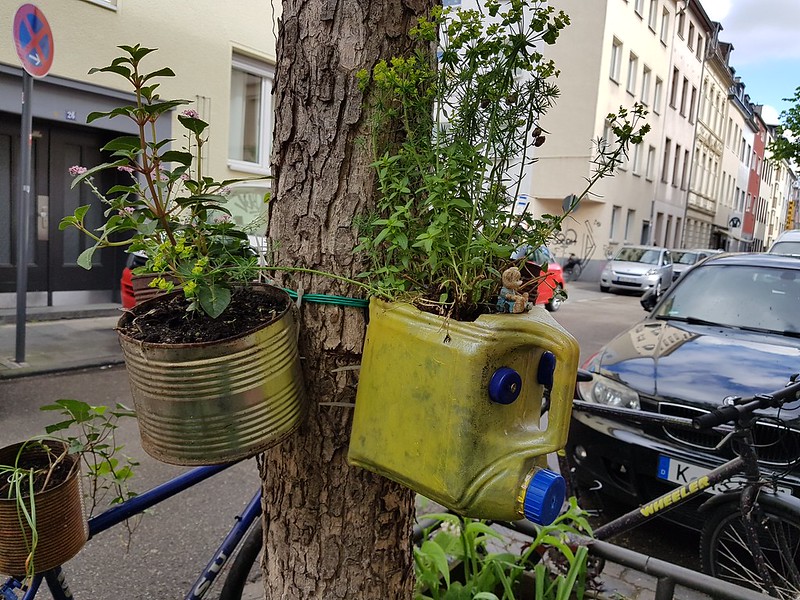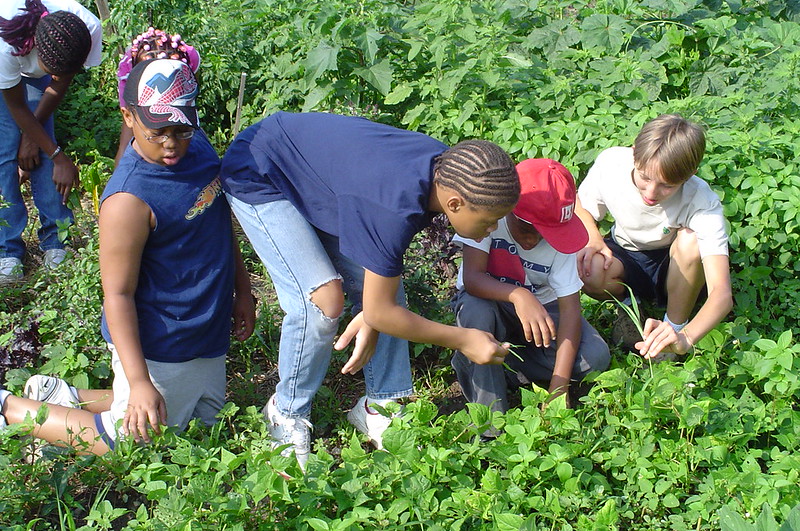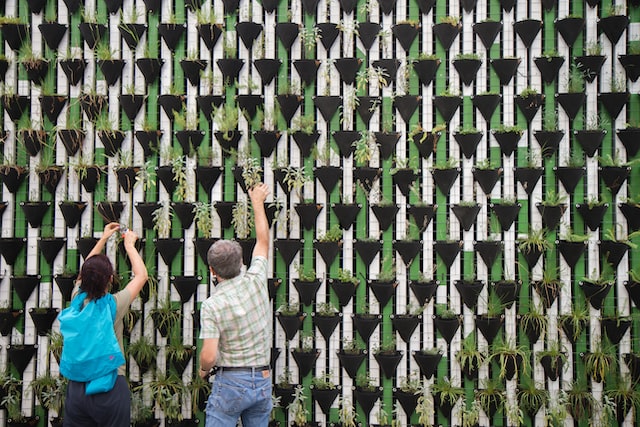Guerrilla gardening and community gardening are both beneficial to the environment, but they differ in a few key ways. Guerrilla gardening is aimed at beautifying public areas without permission from authorities; whereas, community gardens require planning and organization by members of the community. Both forms of gardening can have positive impacts on our communities such as providing access to fresh produce or encouraging people to connect with nature.
What is Guerrilla Gardening?
(Photo By sebastiankauer on Flickr)

Guerrilla gardening refers to the act of planting flowers, vegetables, or other plants in public spaces without the permission of the property owner. Guerrilla gardeners typically choose sites that are neglected, abandoned, or otherwise in need of beautification, such as vacant lots, medians, and traffic islands. The aim of guerrilla gardening is to improve the appearance of a space and provide a temporary, but much-needed, boost to local biodiversity.
What is Community Gardening?
(Photo By fiveriversmetroparks on Flickr)

Community gardening, on the other hand, refers to a more structured form of urban agriculture. Community gardens are typically established on public land, but may also be located on private property with the permission of the owner. These gardens are typically managed by a group of individuals who come together to cultivate the land, often for the purpose of growing their own food. Community gardens may also serve as a source of community pride, as well as a gathering place for social events and educational programs.
Guerrilla gardening Vs. Community gardening – Key differences
Guerrilla gardening is a type of gardening where people plant gardens in public places without permission. Community gardening is a type of gardening where people garden together in a shared space. Both types of gardening can be used to beautify an area, but guerrilla gardening is more about reclaiming unused spaces and community gardening is more about building community.
Purpose: The primary purpose of guerrilla gardening is to improve the appearance of a space and provide a temporary boost to local biodiversity, while the primary purpose of community gardening is to provide a sustainable source of fresh produce and promote community engagement.
Management: Guerrilla gardening is often done by individuals acting independently, while community gardens are typically managed by a group of individuals who work together to cultivate the land.
Legal Status: Guerrilla gardening is often illegal, as it involves planting on private or public property without permission. Community gardening, on the other hand, is typically legal, as it is done with the permission of the property owner.
Longevity: Guerrilla gardening projects are typically temporary, lasting only as long as the plants continue to grow. Community gardens, on the other hand, are meant to be sustainable and may be maintained for many years.
The advantages and disadvantages of Guerrilla gardening
Advantages of Guerrilla Gardening:
- Beautification of neglected or abandoned urban areas
- Increased access to green spaces and fresh produce
- Promoting community involvement and social interaction
- Improved air quality and reduction of heat island effect
- Enhanced biodiversity and habitat creation for urban wildlife
Disadvantages of Guerrilla Gardening:
- Lack of legal permission and potential for conflict with property owners
- Risk of vandalism or theft of the plants
- Lack of resources such as water, soil, and tools
- Limited control over maintenance and ongoing care of the garden
- Difficulty in securing long-term sustainability of the project.
The advantages and disadvantages of Community Gardening
Advantages of Community Gardening:
- Improved access to fresh, healthy, and locally grown produce
- Increased physical activity and promotion of healthy lifestyles
- Strengthening of social bonds and community cohesion
- Beautification of public spaces and increased property values
- Environmental benefits, such as reducing waste and promoting biodiversity.
Disadvantages of Community Gardening:
- Limited land availability and competition for prime gardening spots
- Difficulty in securing long-term funding and resources
- Potential conflicts over garden rules and management
- Difficulties in coordinating volunteers and maintaining the garden
- Risk of vandalism or theft of plants and equipment.
What are the different models of gardening?
There are several models of gardening, including:
- Community Gardening: A collaborative effort by a group of individuals to grow and tend a garden, often in a public space.
- Home Gardening: The practice of growing plants and flowers in a personal garden space, such as a backyard or balcony.
- Vertical Gardening: A method of growing plants in stacked layers, often on walls or fences, in order to maximize limited space.
- Guerrilla Gardening: An unauthorized form of gardening in which plants are grown in neglected or abandoned urban areas.
- Organic Gardening: A type of gardening that avoids the use of synthetic chemicals and focuses on using natural methods for soil improvement, pest control, and nutrient management.
- Raised Bed Gardening: A method of gardening in which soil and plants are contained in elevated beds, which can be especially useful for individuals with limited mobility.
- Hydroponic Gardening: A type of gardening that grows plants without soil, using nutrient-rich water and other materials.
- Square Foot Gardening: A method of growing plants in compact, square-shaped beds, using a specific planting technique and grid system.
- Urban Farming: A type of gardening and agriculture that takes place in urban areas, often with the aim of producing food for local consumption.
What are the types of community gardens?
Community gardens come in a variety of shapes and sizes. They can be large or small, formal or informal, private or public. The one thing they all have in common is that they are created and maintained by a group of people who live in the same community.
Some community gardens are run by local governments or non-profit organizations, while others are started and managed by private individuals or businesses. There is no right or wrong way to start a community garden – it all depends on the needs and wants of the people who will be using it.
The most important thing is that everyone involved feels ownership over the space and has a say in how it’s used.
Here are some of the different types of community gardens you might find in your neighbourhood:
Allotment Gardens: These are usually managed by local governments or non-profit organizations. Individuals or families can rent out a plot of land to grow their own food. Allotment gardens often have waiting lists, so they’re not always easy to get into. But they’re a great option if you want your own space to garden without having to maintain an entire yard on your own.
Neighbourhood Gardens: These are usually managed by a group of residents who live near each other. Everyone has their own plot of land to garden, but there is also shared space where everyone can come together to socialize, grow plants that need more sun/water/space than individual plots
What are the types of community Guerrilla gardens?
There are many types of community guerrilla gardens, each with their own unique approach to gardening. Here are some of the most popular types:
- Food forests: These gardens are designed to mimic natural ecosystems, with a variety of edible plants all growing together in an interconnected way.
- Permaculture gardens: These gardens focus on sustainable, low-maintenance gardening practices that work with nature instead of against it.
- Medicinal herb gardens: These gardens grow a variety of medicinal herbs that can be used for natural healing remedies.
- pollinator–friendly gardens: These gardens are designed to attract and support local pollinators like bees and butterflies.
- Edible landscaping: This type of community garden uses fruit and nut trees, as well as other edible plants, to beautify public spaces while also providing food for the community.
What is the goal of a community garden?
The goal of a community garden is to create a shared green space for the benefit of the local community. Community gardens are typically located in public spaces and are open to participation from anyone in the community. They may be used for growing a variety of plants, including flowers, vegetables, and herbs, and can serve as a source of fresh produce, a place for recreation and social interaction, and a means of promoting environmental sustainability.
The specific goals of a community garden can vary depending on the needs and desires of the local community, but some common objectives include:
- Improving access to fresh, healthy, and locally grown produce
- Promoting physical activity and healthy lifestyles
- Strengthening social bonds and community cohesion
- Beautifying public spaces and increasing property values
- Providing opportunities for education and environmental stewardship
The goal of a community garden is to create a positive impact on the community by bringing people together around a shared passion for gardening and the environment. Community gardens provide a space for individuals to connect with nature, learn new skills, and contribute to the well-being of their communities.
What do people do in a community garden?
In a community garden, people engage in a variety of activities related to gardening and growing plants. Some common activities include:
- Planting and caring for vegetation: Community gardeners may plant and care for a variety of plants, including flowers, vegetables, and herbs.
- Harvesting produce: Community gardeners may harvest the fruits of their labor, such as fresh vegetables, herbs, and fruits, for personal consumption or to share with others.
- Participating in workshops and educational programs: Many community gardens offer workshops and educational programs to help members learn new gardening skills and techniques.
- Hosting social events: Community gardens can serve as a gathering place for community events, such as potlucks, festivals, and educational events.
- Volunteering: Community gardening often involves volunteering, such as participating in community clean-up events, helping with garden maintenance, or serving as a mentor to other gardeners.
- Engaging in environmental stewardship: Community gardens provide an opportunity for individuals to take an active role in environmental stewardship and sustainability, such as composting, water conservation, and wildlife habitat creation.
A community garden is a place for people to come together and engage in a shared passion for gardening and the environment. Community gardens can serve as a source of fresh produce, a place for recreation and social interaction, and a means of promoting environmental sustainability.
What makes a community garden successful?
A community garden can be successful for a variety of reasons, but some key factors that contribute to its success include:
- Community involvement: A strong sense of community ownership and engagement is essential for a successful community garden. Community members should feel invested in the garden and be willing to participate in its maintenance and development.
- Sufficient resources: A community garden requires resources such as funding, equipment, materials, and volunteers to be successful. Sufficient resources can help to ensure the long-term viability of the garden and allow it to grow and thrive.
- Effective leadership: Strong leadership is important for the success of a community garden. A dedicated group of individuals should be in charge of the day-to-day operations of the garden, as well as its long-term planning and development.
- Support from local authorities: Support from local authorities, such as the city government, can help to ensure the success of a community garden by providing resources, protection from vandalism, and access to necessary services, such as water and waste management.
- Clear goals and objectives: A community garden should have clear goals and objectives, such as providing access to fresh produce, promoting physical activity, or creating a green space for the community. Having a clear purpose can help to guide the development and management of the garden and ensure its success.
- Effective communication: Effective communication between community members, leaders, and local authorities is essential for the success of a community garden. Regular meetings and updates can help to ensure that everyone is on the same page and working towards common goals.
The success of a community garden is determined by a complex interplay of factors, and what works best will depend on the specific needs and circumstances of each community. However, by paying attention to these key factors and working together, community gardens can be successful and provide a valuable resource for the community.
How do you promote a community garden?
Promoting a community garden can help to raise awareness, increase participation, and build support for the project. Some ways to promote a community garden include:
- Reach out to local community organizations and groups: Collaborating with local organizations and groups, such as schools, churches, and neighborhood associations, can help to increase visibility and attract new participants to the garden.
- Use social media and online platforms: Utilizing social media and online platforms, such as Facebook, Twitter, and Instagram, can help to reach a wider audience and promote the community garden to people who may not have heard of it otherwise.
- Host public events and open houses: Hosting public events and open houses, such as plant sales, potlucks, and educational workshops, can help to bring people together and generate interest in the garden.
- Offer volunteer opportunities: Providing volunteer opportunities, such as planting and maintenance days, can help to engage the community and build support for the garden.
- Partner with local businesses: Partnering with local businesses, such as supermarkets and food co-ops, can help to promote the garden and provide resources, such as funding and materials.
- Utilize local media: Reaching out to local media, such as newspapers, radio stations, and television networks, can help to raise awareness and generate interest in the community garden.
- Build partnerships with local government and other organizations: Building partnerships with local government and other organizations, such as parks departments and non-profits, can help to ensure the success and sustainability of the community garden.
Promoting a community garden requires a comprehensive and sustained effort to reach out to the community and build support. By utilizing a variety of strategies and working together, community gardeners can help to raise awareness, increase participation, and ensure the success of their garden.
What is the impact of community gardens?
Community gardens have a number of positive impacts on both the individual and the community. Gardening has been shown to have a number of health benefits, including reducing stress, improving mental well-being, and increasing physical activity. In addition, community gardens can provide a sense of community and social cohesion, as well as a source of fresh, healthy food.
A study by the University of California Cooperative Extension found that community gardens can also serve as a form of economic development, providing jobs and business opportunities. The study found that community gardens can generate income for gardeners, create new businesses, and attract customers to local businesses.
In addition to the benefits for individuals and the community, community gardens also have environmental benefits. They can help to green cities and improve air quality, as well as provide habitat for wildlife.
What are some challenges facing community gardens?
There are many challenges that community gardens face. One challenge is finding enough space to garden. Another challenge is getting people to commit to gardening and working together. And lastly, keeping the garden going year after year can be a challenge.
What is the goal of a Guerrilla garden?
The goal of a guerrilla garden is to beautify and revitalize neglected or abandoned urban spaces. Guerrilla gardening is often motivated by a desire to bring green spaces and fresh produce to urban areas that lack access to these resources. The act of guerrilla gardening itself can also promote community involvement, encourage social interaction, and raise awareness about environmental issues. Guerrilla gardening can also serve as a form of political or social activism, with gardeners seeking to reclaim and repurpose public spaces for the benefit of their communities. Ultimately, the goal of guerrilla gardening is to create positive change in urban environments and promote a more sustainable, livable, and enjoyable urban landscape.
What do people do in a Guerrilla garden?
In a guerrilla garden, people plant and care for various types of vegetation, such as flowers, herbs, and vegetables, in an urban area that is neglected or abandoned. This can be done on public or private land, but typically without the permission of the property owner. Guerrilla gardeners often work together in small groups, using their own resources such as soil, seeds, tools, and water to transform a previously barren or neglected area into a lush, green oasis.
In addition to planting and caring for the garden, guerrilla gardeners may also engage in a variety of other activities, such as community events, workshops, and educational programs. These events and activities can help to raise awareness about the benefits of guerrilla gardening and promote the growth of similar efforts in other areas. Overall, guerrilla gardening is a way for people to come together, beautify their communities, and create positive change in urban environments.
Is a Guerrilla garden usually successful?
The success of a guerrilla garden can vary depending on several factors, including the level of community support, availability of resources, and the response of property owners and local authorities. Some guerrilla gardens have been highly successful, thriving for many years and serving as important sources of fresh produce, green space, and community engagement. In these cases, the garden may receive widespread support from the community and may even receive official recognition or support from local authorities.
However, not all guerrilla gardens are successful. Some face challenges such as vandalism, theft, lack of resources, or opposition from property owners or local authorities. In some cases, the garden may be short-lived or may struggle to maintain its viability over time.
Overall, the success of a guerrilla garden is determined by a complex interplay of factors, and it can be difficult to predict the outcome of a given garden. Nevertheless, many guerrilla gardeners are motivated by a desire to create positive change in their communities and are undeterred by the potential obstacles and challenges.
Who started guerrilla gardening?
Guerrilla gardening was started in the 1970s by a group of activists in New York City who were frustrated with the city’s lack of green space. They began planting flowers and vegetables in vacant lots and other underutilized spaces. The movement quickly gained popularity and spread to other cities. Today, there are guerrilla gardeners all over the world.
Is guerrilla gardening illegal?
Guerrilla gardening is often associated with illegal activities, such as trespassing on private property to plant gardens. However, not all guerrilla gardeners are criminals; in many cases, they are simply passionate about gardening and want to beautify their community. While there are some risks associated with guerrilla gardening (such as getting caught by the police), many people find it to be a rewarding experience.
Featured Image By – Photo by Daniel Funes Fuentes on Unsplash









